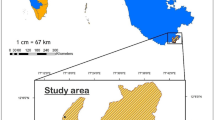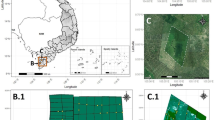Summary
Populations of the vole,Clethrionomys rufocanus, in a lowland woodlot of Hokkaido were studied for the presence of effects of prebaiting on censusing by the capture-recapture method. A grid of 121 live-traps, spaced 5 m apart, was laid out on each of two plots, one of which alone was prebaited three days long. Owing to very high densities and great trap-efficiency, sufficient and favourable samples could be available for statistical analysis, except the trend of delayed catch for young in sampling. The population on either plot, however, proved to be markedly variable in catchability of unmarked animals in the course of trapping; while the probability of recapture was counted as invariable on the average from day to day, the recapture frequency was different between juveniles, subadults and adults. Needless to say, the catchability was distinctly greater for marked voles than for unmarked ones, whether prebaited or not, through the trapping period, except that the first-day catchability for unmarked ones on the prebaited plot seems not to be significantly lower than that for marked ones.
Consequently, it turns out that the prebaiting has almost never helped to eliminate the important bias induced by differential trap-response of marked and unmarked animals; its contribution is only that the catchability for unmarked ones is slightly higher on the part of the prebaited plot on earlier days of the period.
In accordance with the heterogeneous catchability, the Γ-form distribution analogous to the geometric could be applied with thorough fitness to the capture frequency in order to estimate the whole populations. The fact that the estimates are reliable, being not at any rate underestimates, was further confirmed by the result of a follow-up work conducted by means of the removal method with wider trap-spacing which brought forth distinct underestimation chiefly referable to unexposure to traps of the partial populations. The subject of unexposure was discussed by laying stress on the relation between minimum range length and trap-spacing.
Similar content being viewed by others
References
Andrzejewski, R., J. Babińska, E. Bock andJ. Gliwicz (1968) Results of rodent trapping using cheese and fried wick baiting.Small Mamm. Newsletters,2: 45–46.
Babińska J. andE. Bock (1969) The effect of prebaiting on captures of rodents.Acta Theriol.,4: 267–270.
Chitty, D. andD. A. Kempson (1949) Prebaiting small mammals and a new design of live trap.Ecology,30: 536–542.
Eberhardt, L., T. J. Peterle andR. Schofield (1963) Problems in a rabbit population study.Wildl. Monogr.,10, 51pp.
Eberhardt, L. (1969) Population estimates from recapture frequencies.J. Wildl. Mgt.,33: 28–39.
Edwards, W. R. andL. Eberhardt (1967) Estimating cottontail abundance from live-trapping data.J. Wildl. Mgt.,31: 87–96.
Geis, A. D. (1955) Trap response of the cottontail rabbit and its effect on censusing.J. Wildl. Mgt.,19: 467–472.
Getz, L. L. (1961) Responses of small mammals to live-traps and weather conditions.Amer. Midl. Nat.,66: 160–170.
Grodziński, W., Z. Pucek andL. Ryszkowski (1966) Estimation of rodent numbers by means of prebaiting and intensive removal.,Acta Theriol.,11: 297–314.
Huber, J.J. (1962) Trap response of confined cottontail populations.J. Wildl. Mgt.,26: 177–185.
Jolly, G.M. (1965) Explicit estimates from capture-recapture data with both death and immigration-stochastic model.Biometrika,52: 225–247.
Kanamori, M. andR. Tanaka (1968) Studies on population ecology of the vole,Microtus montebelli, in mountain grasslands of of Sugadaira and its adjacent areas. I. Results of research on five populations in 1966–1967.Bull. Sugadaira Biol. Lab., Tokyo Kyoiku Univ.,2: 17–40. (in Japanese).
Krebs, C. J. (1966) Demographic changes in fluctuating populations ofMicrotus californicus.Ecol. Monogr.,36: 239–273.
Leslie, P. H., D. Chitty andH. Chitty (1953) The estimation of population parameters from data obtained by means of the capture-recapture method. III. An example of the practical application of the method.Biometrika,40: 137–169.
Nixon, C. M., W. R. Edwards andL. Eberhardt (1967) Estimating squirrel abundance from livetrapping data.J. Wildl. Mgt.,31: 96–101.
Seber, G. A. F. (1965) A note in the multiple-recapture census.Biometrika,52, 249–259.
Skellam, J. G. (1948) A probability distribution derived from the binomial distribution by regarding the probability of success as variable between the sets of trials.J. Royal Stat. Soc. B,10: 257–261.
Stickel, L. F. (1954) A comparison of certain methods of measuring ranges of small mammals.J. Mamm.,33: 1–15.
Tanaka, R (1963) On the problem of trap-response types of small mammal populations.Res. Popul. Ecol.,5: 139–146.
Tanaka, R. (1966) A possible discrepancy between the exposed and the whole population depending on range-size and trap-spacing in vole populations.Res. Popul Ecol.,8: 93–101.
Tanaka, R. andM. Kanamori (1967) New regression formula to estimate the whole population for recapture-addicted small mammals.Res. Popul. Ecol.,9: 83–94.
Tanaka, R. andM. Kanamori (1969) Inquiry into effects of prebaiting on removal census in a vole population.Res. Popul. Ecol.,11: 1–13.
Tanton, M. T. (1965) Problems of live-trapping and population estimation of the wood mouse,Apodemus sylvaticus.J. Anim. Ecol. 34: 1–22.
Ueda, M., S. Higuchi, B. Igarashi, M. Maeda, T. Kuwabata, K. Ota, H. Abe, Y. Fujimaki, J. Fujikura andT. Takayasu (1966) Historical review of studies on theBedford’s red-backed vole,Clethrionomys rufocanus bedfordiae (Thomas).Bull. Governm. For. Exper. Stat. (Japan),191, 100pp. (in Japanese).
Author information
Authors and Affiliations
Additional information
Contribution from JIBP-PT No. 88, carried out by the grant from the expenditure of Education Department to the specific study on “Dynamics of Biosphere”.
Rights and permissions
About this article
Cite this article
Tanaka, R. A field study of the effect of prebaiting on censusing by the capture-recapture method in a vole population. Res Popul Ecol 12, 111–125 (1970). https://doi.org/10.1007/BF02511086
Issue Date:
DOI: https://doi.org/10.1007/BF02511086




